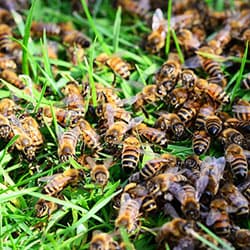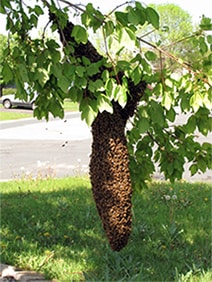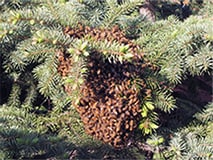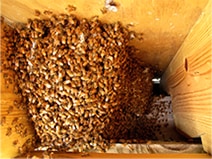Honey Bee Swarms
Report a swarm: Call 651-436-7915
Honey bee swarms are not dangerous, but they do need to find an appropriate home. Beekeepers can help by collecting the swarm. If you see a swarm of honey bees, it's important to report it as soon as possible. Call Bob Sitko at the phone number above. He will try to find a beekeeper who can remove them.
Be prepared to provide the following information when you call.
- How long has the swarm been there?
- Where are they located, such as 5 feet up a tree at xxx Street, City, State?
- What is your phone number?
- Can you take a photo of a bee or swarm as close-up as you feel comfortable?
Our members can only help with honey bees. If you’re unsure whether or not the swarm is honey bees, refer to the pictures on this and our Learn About Bees page.

Swarms are natural
Honey bees are the only type of bees that swarm. It is part of their natural reproductive lifecycle. The swarming season in MN usually runs from May through September. Warm weather and plentiful supplies of nectar and pollen stimulate the queen to lay more eggs. The resulting large numbers of young bees causes overcrowding in the hive, impeding both the queen’s desire to lay eggs and the worker bees’ ability to add more honey and pollen. Swarms are the natural outcome of these circumstances. MHBA members may be able to safely retrieve the swarm and give it a proper home. Bees collected and relocated in this way continue doing their good deeds of pollinating and making honey.
More about swarming
Fortunate are those who witness a swarm of bees flying to a resting place. Honey bees are not early risers and usually fly between 10am and 2pm on a sunny day. The queen and about half the colony (5,000 to 20,000 worker bees) will swirl from their hive and alight on a tree branch, fire hydrant, mailbox or even a car. The bees form a tight cluster around the queen while scout bees go out looking for a hollow space in which to make their new home. It may take a few hours or up to two days for a new home to be chosen. Bees in a swarm are not aggressive or inclined to sting while they wait. They are lazy and have filled their bellies with honey before leaving the hive, since they knew they would be without food until they found their new location. They are temporarily homeless, so they have nothing to defend.
Removal of a swarm
A swarm of honey bees located inside the walls or eaves of a building usually requires a contractor that can remove the materials to get access to the bees. There are several methods for collecting a swarm that is out in the open. The first step is to confirm they are really honey bees. See our Learn About Bees page for pictures of honey bees, yellow jackets and hornets.
- Place an empty hive box under the swarm and shake or drop the bees into the box. Most of the bees will continue to move into the box over the next hour or so. Then close and seal the box and transport to where you want the hive.
- Remove the tree branch with the swarm, and set it on top of the open hive box. The bees should move into the box, and you can then close it up and transport it.
Want to be a swarm chaser?
MHBA members may sign up by completing our Swarm Chaser sign-up form for the areas around town you are willing to cover. If we get a call/email about a swarm, our swarm coordinator will reference this list and try to contact volunteers to collect the swarm. There is no guarantee you will get a call, but you definitely won’t get one if you don’t sign up.
Examples of Honey Bee Swarms



